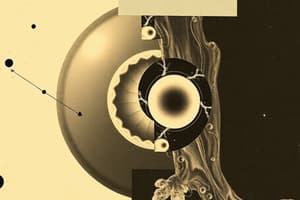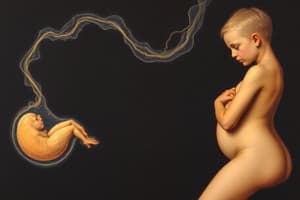Podcast
Questions and Answers
After ovulation, where does fertilization typically occur in the female reproductive system?
After ovulation, where does fertilization typically occur in the female reproductive system?
- Ovary.
- Vagina.
- Fallopian tube. (correct)
- Uterus.
What must occur before fertilization can happen?
What must occur before fertilization can happen?
- Menstruation to prepare the uterine lining.
- Implantation of the blastocyst.
- Ovulation, where the oocyte is released from the ovary. (correct)
- Capacitation of the sperm, allowing it to penetrate the oocyte.
Which cellular process is initiated when the sperm successfully penetrates the oocyte during fertilization?
Which cellular process is initiated when the sperm successfully penetrates the oocyte during fertilization?
- Spermatogenesis.
- Meiosis II completion. (correct)
- Oogenesis.
- The acrosomal reaction.
Why is the formation of the zona pellucida crucial for successful fertilization?
Why is the formation of the zona pellucida crucial for successful fertilization?
What event immediately follows the fusion of the sperm and egg nuclei during fertilization?
What event immediately follows the fusion of the sperm and egg nuclei during fertilization?
During embryonic development, where does the pharynx originate?
During embryonic development, where does the pharynx originate?
In which week of human development do the pharyngeal arches appear?
In which week of human development do the pharyngeal arches appear?
How many pharyngeal arches are formed during embryonic development in humans?
How many pharyngeal arches are formed during embryonic development in humans?
What is another name commonly used to refer to the pharyngeal arches?
What is another name commonly used to refer to the pharyngeal arches?
Which of the following accurately describes the histological composition of a pharyngeal arch?
Which of the following accurately describes the histological composition of a pharyngeal arch?
Which germ layers cover the pharyngeal arches externally and internally?
Which germ layers cover the pharyngeal arches externally and internally?
What structure is formed by the first pharyngeal groove and the first pharyngeal pouch?
What structure is formed by the first pharyngeal groove and the first pharyngeal pouch?
What structure develops from the second, third, and fourth pharyngeal grooves?
What structure develops from the second, third, and fourth pharyngeal grooves?
Where does fertilization typically occur in the female reproductive system?
Where does fertilization typically occur in the female reproductive system?
Approximately how long does the oocyte remain viable for fertilization after ovulation?
Approximately how long does the oocyte remain viable for fertilization after ovulation?
What is the approximate duration sperm can survive within the female reproductive tract?
What is the approximate duration sperm can survive within the female reproductive tract?
When does the zygote's segmentation process typically commence following fertilization?
When does the zygote's segmentation process typically commence following fertilization?
What term describes the structure formed during days 1 to 5 of embryonic development?
What term describes the structure formed during days 1 to 5 of embryonic development?
Which types of cell junctions are involved in the compaction process of the morula?
Which types of cell junctions are involved in the compaction process of the morula?
What is the primary event that occurs during the cavitation process in early embryonic development?
What is the primary event that occurs during the cavitation process in early embryonic development?
Which two main components comprise the blastocyst structure?
Which two main components comprise the blastocyst structure?
During which timeframe does blastocyst hatching typically occur post-fertilization?
During which timeframe does blastocyst hatching typically occur post-fertilization?
Which hormones play a critical role in preparing the endometrial lining for blastocyst implantation?
Which hormones play a critical role in preparing the endometrial lining for blastocyst implantation?
Which of the following structures does not primarily originate from the branchial arches?
Which of the following structures does not primarily originate from the branchial arches?
What structures are derived from Meckel's cartilage during development?
What structures are derived from Meckel's cartilage during development?
Which dental structures are derived from neural crest cells?
Which dental structures are derived from neural crest cells?
What is a key objective when studying the development of the central nervous system?
What is a key objective when studying the development of the central nervous system?
When do the cranial and caudal neuropores typically close during embryonic development?
When do the cranial and caudal neuropores typically close during embryonic development?
Which of the following accurately lists structures derived from neural crest cells?
Which of the following accurately lists structures derived from neural crest cells?
What event characterizes neurulation, and during which week of development does it occur?
What event characterizes neurulation, and during which week of development does it occur?
Which of the following correctly identifies the primary and secondary brain vesicles?
Which of the following correctly identifies the primary and secondary brain vesicles?
Which structures derive from the diencephalon and telencephalon during development?
Which structures derive from the diencephalon and telencephalon during development?
Which adult structures are derived from the rhombencephalon during embryonic development?
Which adult structures are derived from the rhombencephalon during embryonic development?
What are the primary curvatures that form during the development of the central nervous system (CNS)?
What are the primary curvatures that form during the development of the central nervous system (CNS)?
What are the layers of the neural tube and what structures do they form?
What are the layers of the neural tube and what structures do they form?
What are the functions of the basal and alar plates in the developing neural tube?
What are the functions of the basal and alar plates in the developing neural tube?
Which cell types are derived from neuroepithelial cells within the developing nervous system?
Which cell types are derived from neuroepithelial cells within the developing nervous system?
Which of the following accurately lists glial cell types and their respective functions within the central nervous system?
Which of the following accurately lists glial cell types and their respective functions within the central nervous system?
What is the mesenchyme, and how does it form during embryonic development?
What is the mesenchyme, and how does it form during embryonic development?
Flashcards
What is fertilization?
What is fertilization?
The process of a sperm cell uniting with an egg cell.
Where does fertilization occur?
Where does fertilization occur?
The female reproductive organ where fertilization typically occurs.
What happens during fertilization?
What happens during fertilization?
Haploid reproductive cells (sperm and egg) fuse to form a diploid zygote.
What is a zygote?
What is a zygote?
Signup and view all the flashcards
What happens after fertilization?
What happens after fertilization?
Signup and view all the flashcards
Where Fertilization Happens?
Where Fertilization Happens?
Signup and view all the flashcards
Ovum Fertilization Window
Ovum Fertilization Window
Signup and view all the flashcards
Sperm Survival Time
Sperm Survival Time
Signup and view all the flashcards
Start of Zygote Segmentation
Start of Zygote Segmentation
Signup and view all the flashcards
Morula
Morula
Signup and view all the flashcards
Morula Compaction
Morula Compaction
Signup and view all the flashcards
Cavitation Defines?
Cavitation Defines?
Signup and view all the flashcards
Blastocyst Components
Blastocyst Components
Signup and view all the flashcards
Blastocyst Hatching
Blastocyst Hatching
Signup and view all the flashcards
Hormones for Implantation
Hormones for Implantation
Signup and view all the flashcards
Embryonic Pharynx Formation
Embryonic Pharynx Formation
Signup and view all the flashcards
Pharyngeal Arches Timing
Pharyngeal Arches Timing
Signup and view all the flashcards
Number of Pharyngeal Arches
Number of Pharyngeal Arches
Signup and view all the flashcards
Pharyngeal Arches Alternative Name
Pharyngeal Arches Alternative Name
Signup and view all the flashcards
Pharyngeal Arch Composition
Pharyngeal Arch Composition
Signup and view all the flashcards
Pharyngeal Arch Covering Layers
Pharyngeal Arch Covering Layers
Signup and view all the flashcards
First Groove and Pouch Result
First Groove and Pouch Result
Signup and view all the flashcards
Derivatives of the Third and Fourth Pharyngeal Pouches
Derivatives of the Third and Fourth Pharyngeal Pouches
Signup and view all the flashcards
Laryngeal Cartilages
Laryngeal Cartilages
Signup and view all the flashcards
Meckel's Cartilage Origin
Meckel's Cartilage Origin
Signup and view all the flashcards
Neural Crest Dental Derivatives
Neural Crest Dental Derivatives
Signup and view all the flashcards
Study of CNS Development
Study of CNS Development
Signup and view all the flashcards
Neuropore Closure Timing
Neuropore Closure Timing
Signup and view all the flashcards
Neural Crest Structures
Neural Crest Structures
Signup and view all the flashcards
Neurulation
Neurulation
Signup and view all the flashcards
Brain Vesicles (Primary/Secondary)
Brain Vesicles (Primary/Secondary)
Signup and view all the flashcards
Telencephalon and Diencephalon
Telencephalon and Diencephalon
Signup and view all the flashcards
Rhombencephalon Structures
Rhombencephalon Structures
Signup and view all the flashcards
CNS Development Curvatures
CNS Development Curvatures
Signup and view all the flashcards
Neural Tube Layers
Neural Tube Layers
Signup and view all the flashcards
Basal vs. Alar Plates Function
Basal vs. Alar Plates Function
Signup and view all the flashcards
Cells from Neuroepithelial Cells
Cells from Neuroepithelial Cells
Signup and view all the flashcards
Types of Glial Cells and Function
Types of Glial Cells and Function
Signup and view all the flashcards
What is Mesenchyme?
What is Mesenchyme?
Signup and view all the flashcards




